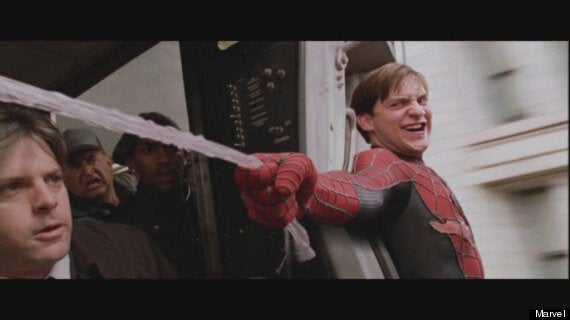Superheroes' powers are usually pretty far-fetched, but after research into spider webbing it seems they are not quite as unbelievable as they seem.
In Spiderman 2, there is a dramatic scene where the superhero stops a runaway train with his spider webbing. Now, a group of physics students is claiming a spider's web really could stop a moving subway car.
According to the University of Leicester masters students, the strength of Spiderman's web "would be proportional to that of real spiders".

The moment Tobey Maguire uses his spider web to stop a train
The group of three fourth-years calculated the material properties of webbing needed to stop four crowded subway carriages.
Their paper, "Doing whatever a spider can", was published in the latest volume of the University of Leicester’s Journal of Physics Special Topics.
Students James Forster, Mark Bryan and Alex Stone first calculated the force needed to stop the four R160 New York City subway cars.
To do this, they used the momentum of the train at full speed, the time it takes the train to come to rest after the webs are attached, and the driving force of the powered R160 subway car.
The students found the force Spiderman's webs exert on the train to be 300,000 newtons.They were then able to calculate the strength and toughness of the webs.
They found the Young’s modulus [or stiffness, to you and I] of the web would be 3.12 gigapascals. As spider's silk ranges from 1.5 gigapascals to 12 gigapascals in the orb-weaver spiders, the students decided the possibility of the train stunt would be "very reasonable".
21-year-old Alex Stone, from Kingston upon Thames, said: "It is often quoted that spider-webs are stronger than steel, so we thought it would be interesting to see whether this held true for Spiderman's scaled up version. Considering the subject matter we were surprised to find out that the webbing was portrayed accurately."
The toughness of the silk was calculated as almost 500 megajoules per cubic metre. This is in line with web from a Darwin's Bark Spider - an orb-weaver with the strongest known webbing of any spider.
The students concluded the “friendly neighbourhood” superhero’s webbing is indeed a proportional equivalent of that of a real spider – and, consequently, it would be feasible for him to stop a moving train.
James Forster, 22, from Wisbech, added: "While our work may not seem to be very serious it has helped teach us about applying physics to varying situations as well as the peer review process through which scientific journals operate. This makes it an invaluable experience to anyone who wants to go into research later in life."
The Physics Special Topics journal is published every year, and features original short papers written by students in the final year of their four-year Master of Physics degree.
Course leader Dr Mervyn Roy, a lecturer at the University’s Department of Physics and Astronomy, said: “A lot of the papers published in the Journal are on subjects that are amusing, topical, or a bit off-the-wall. Our fourth years are nothing if not creative!
“But, to be a research physicist - in industry or academia - you need to show some imagination, to think outside the box, and this is certainly something that the module allows our students to practice."